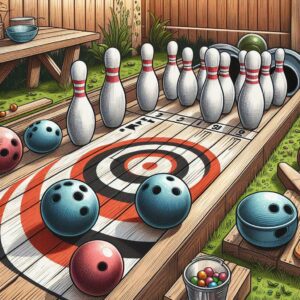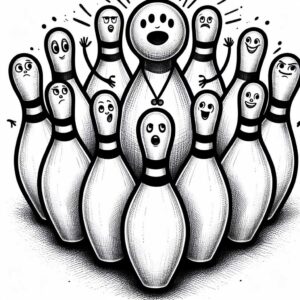Bowling is a sport loved by millions across generations for its simple concept yet immense potential for talent, strategy, and fun competition. The sound of crashing pins gives adrenaline rushes to hobbyists and pros alike.
However, when it comes to bowling leagues or tournaments, skill levels can vary widely amongst participants. This is where handicapping comes in.
A bowling handicap is a scoring advantage given to lower-averaging bowlers to help even the playing field against more experienced counterparts when they compete. This levels the scores, making games more exciting and competitive.
Handicap calculations enable teams to supplement their total score with “bonus” pins. This gives all players, regardless of average, an equal chance at winning.
With nearly 95 million people taking to the lanes every year, bowling handicaps help foster sporting chance, comradery, and consistent participation across skill levels.
Let’s explore handicapping further:
Determining Your Handicap Score
Before stepping foot on the lane, league secretaries assess player averages to determine handicap allotments. Scores are meticulously tabulated each week to formulate a baseline average for each bowler.
Think of this baseline as an approximation of your current scoring capability. As a beginner, this may start lower while more advanced players have higher benchmarks.
Once averages are calculated, handicaps kick in to authorize additional pinfalls per game based on the difference between your baseline and the maximum 300 pins possible. This is generally a straightforward percentage allowance.
For example:
- Bowler 1 Has a 152 Average -> Handicap of 148 pins (100% of 300-152)
- Bowler 2 Has a 112 Average -> Handicap of 188
The lower the average, the higher the pins you receive. Beginners could start with caps near 100% while seasoned professionals may be allotted few or no bonus pins during league play when averages showcase their consistency.
How Handicap Scores Are Applied
Handicapping adds suspense since the victor cannot be determined until supplemental pins are tallied.
Teams go head-to-head based on their gross score before factoring in handicaps. Then the predetermined handicap values per player are included to reach a net score.
Think of it as an equal opportunity advantage to make up for skill level differences. Handicapping enables rookie players to contribute competitively alongside professionals during team games.
It keeps the experience fun rather than one-sided while letting experienced players focus on personal performance targets.
League secretaries often calculate handicaps before a season starts and then reassess on a quarterly or annual basis to keep parity.
Some highly competitive tournaments or matches may be evaluated per game week over week. Handicaps can apply to individuals or teams as a whole based on rules.
Factors Impacting Handicapping Accuracy
As with any system, accuracy is critical for effectiveness. Handicaps becoming too advantageous can have unsportsmanlike effects.
- Sandbagging even emerges where players intentionally limit performance when averages are tabulated to receive higher handicap scores.
To increase fairness, key factors should be considered:
- Sufficient Sample Size – A Minimum of 12-15 games are recommended to set a baseline average handicap from
- Weekly Checks – secretaries assess if big swings occur indicating sandbagging
- New Player Exceptions – First years may have temporary supplemental handicaps while their averages set
- Score Cap Maximums – Curb excessively high single-game handicap allotments
- Consistency – Handle major shifts in averages with care week over week
The optimal system lets newer players feel included and motivated to improve rather than get discouraged when outscored in each game.
It should reward veterans for keeping consistency while off nights happen. Most importantly, the handicapping differentials set should feel reasonable to all teams involved.
Other Handicapping Systems
While straight percentage differentials based on averages make handicapping easy to understand for most leagues, some nuances exist:
- Plus & Minus Method – Similar to golf, subtract the lower average from the higher one then split that number as the handicap allotments applied
- Class Method – Bowlers are grouped in classes where only those in specified tiers (often 5 pins apart) compete for weekly prizes
- Team Method – Total handicap determined by summing individuals and then applying it evenly across all participating team players in a lane match
The diversity keeps things exciting if your league decides to ever adjust formats.
The Holmes Handicapping approach adds algorithmic computations of standard deviation comparisons amongst bowler averages for automated assignments as well.
Beyond the math, the camaraderie and excitement bowling handicaps enable is unmatched. Nothing beats the thrill of seeing scattered pins give your score the boost it needs to squeak ahead on a tough night. It keeps the fire going to cheer each other on!
Conclusion
Bowling handicaps introduce welcome adaptations to enable motivated hobbyists to become valued teammates, having as much potential to win as seasoned league professionals when skill differences are significant.
Automating handicap calculations based on averages, current performances, and customizable league settings removes hassle so friends can enjoy friendly competition.
Handicaps level the playing field to foster community participation, covering natural dips in consistency so veterans retain interest while novices face fewer barriers to improvement over time.
The icing on the cake is realizing the additional excitement handicaps provide when every person has an opportunity to impact outcomes.
The bonus pins can introduce epic comebacks independent of pure skill alone. This drives the addictive fun and unpredictable nature bowling fans embrace.
Whether new to the lanes or returning after years away, ask your local alley or recreational league about their handicapping system.
The algorithms balance past weeks’ inputs enabling you to maximize fun from day one. Consistent bowlers retain achievements while occasional players find motivation to improve.
That symbiotic nature of friendly competition but tiered skill levels handicapping enables is priceless.
Smack those pins with pride and make new friends along the way. Set up your profile, get playing tips to improve through instructional accessories, and then monitor your average rise as those bonus pins incrementally decrease!
Frequently Asked Questions
How do you handicap in bowling?
In bowling, handicaps are calculated by taking the difference between a bowler’s average score and the maximum possible score (typically 300) and allowing a percentage (often 90%) of that difference as extra pins added to the bowler’s total. This allows lower-average bowlers to compete evenly with higher-average ones.
How does the handicap system work in bowls?
In lawn bowls, handicaps are based on a player’s ability. Higher handicaps are given to less experienced players, which allows them to compete fairly against stronger opponents. Handicaps are on a sliding percentage scale from 0% (for professionals) up to 45% (for absolute beginners).
What does 90% of 230 mean in bowling?
If a bowler has a 230 average, giving them 90% of handicap means allowing them 90% of the difference between their average (230) and the maximum 300 pins. So they would get 90% of (300 – 230) = 90% of 70 = 63 extra pins per game as their handicap.
What is a scratch in bowling?
Scratch bowling refers to bowling without using any handicap scoring. It means scoring a game purely based on the actual number of pins knocked down without any bonus pins given. Scratch leagues allow bowlers of all skill levels to compete purely on their scoring ability.
How do I score my handicap?
First, calculate your average over several games. Then subtract your average from the maximum possible score (typically 300). Take a set percentage of that difference (often 90% but can vary by league) as your handicap allowance per game. After each game, add your handicap pins to your actual score to determine the total score.
How do you set your handicap? A player’s handicap is set based on their average over a 12-15 week rolling average at the start of league play. Handicaps are calculated automatically by applying a set percentage (usually 90%) of the difference between their rolling average and the maximum score. Handicaps are adjusted throughout the season as averages fluctuate.
How do you add scores in bowling?
In bowling, you add scores by total pins felled over the number of frames. There are 10 frames in a game. Spare and strike bonuses allow skilled players to achieve more than 10 frames of points. Totals scores from each frame are added to calculate the total game score. Handicap pins are then added on top to enable scoring parity.
Can you have a negative handicap in bowling?
No, it is not possible to have a negative handicap in bowling. The purpose of a handicap is solely to supplement additional pins for lower-averaging bowlers. Higher averaging players may compete with no handicap but would never be deducted pins due to higher skill. That would defeat the purpose of the evening competition.
What are scratch and handicap in bowling?
In bowling, scratch refers to scoring without handicaps – purely based on total pins knocked down. Handicap scoring adds bonus pins for lower-averaging bowlers to make games more competitive when people have vastly different averages. Both scratch bowlers and those using handicaps can compete in the same leagues and use comparative metrics.





